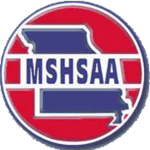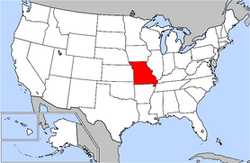Missouri State High School Activities Association
This article has multiple issues. Please help improve it or discuss these issues on the talk page. (Learn how and when to remove these messages)
|
 | |
 | |
| Abbreviation | MSHSAA |
|---|---|
| Formation | 1926 |
| Type | Volunteer; NPO |
| Legal status | Association |
| Purpose | Athletic/Educational |
| Headquarters | 1 North Keene St. Columbia, MO 65205 |
Region served | Missouri |
Membership | 580 schools (approximately) |
Official language | English |
Executive Director | Dr. Kerwin Urhahn |
| Affiliations | National Federation of State High School Associations |
| Staff | 26 |
| Website | mshsaa.org |
| Remarks | (573) 875-4880 |
The Missouri State High School Activities Association (MSHSAA) is the governing body for high school activities throughout the state of Missouri. Approximately 580 high schools are members of MSHSAA.
The MSHSAA conducts championship-level activities in 23 activities. At least 50 member high schools must sponsor a sport for an official championship series to be conducted. Sports such as boys volleyball, field hockey, girls lacrosse, boys softball, and water polo are considered "emerging sports" by MSHSAA, but an official postseason series does not exist with less than 50 schools involved in those activities. MSHSAA also administers sideline cheerleading and dance team activities.
History
The organization was formed in 1926 by a number of schools, both public and private, to oversee championship tournaments. Its first final was in boys' basketball, held that year at Washington University in St. Louis. MSHSAA removed the color barrier in 1952, allowing schools from the MNIAA (Missouri Negro Interscholastic Athletic Association) to join. In the late 1960s, the group unified football tournaments (previously only held locally) to form the Show-Me Bowl that exists today.
School classification
MSHSAA's member schools are organized into groups based on enrollment, with Class 1 being the smallest. In 11-man football the largest is Class 6, comprising the largest 32 schools based on enrollment. Schools wishing to play 8-man football must have an enrollment smaller than 200 total students. Boys' and girls' basketball each have five classifications. Class 5 schools are those with 1,175 students and above; while Class 1 schools are those with 119 students and below.[1] Prior to 2003, the classes were divided into four classes from "A" to "AAAA" (popularly referred to as "1A" to "4A").
However, the number of classes varies by the number of schools that participate in a sport: for example, swimming and diving, speech, debate and theater, only have one class, while girls' softball and girls' volleyball use four classes.
Schools in Missouri are able to form their own conferences and play whichever teams they wish in regular season competition. For example, the Ozark Conference, in the southwest portion of the state, has teams from two classes competing against one another.
Schools are assigned into districts for playoff competition only; districts vary depending on sport, size and geographic location. Also unlike other states, there is no "regional" championship designation; during playoff competition schools are generally organized into brackets that are close in geographic proximity.
Wrestling and track districts, for instance, usually have 10 or more teams due to the nature of competition, while football districts have anywhere from four to five. Beginning with the 2012 football season, districts comprised eight schools. In other sports, district competition is set up like a more traditional tournament bracket at the end of the regular season. The winner of the district tournament advances in the championship series.
Redistricting and regrouping occurs every two years.
Class 5 and Class 4 schools generally come from the state's major metro areas: St. Louis, Kansas City, Springfield, Joplin and Columbia/ Jefferson City, although there are exceptions. Class 3, 2 and 1 schools are generally rural, although some small private city schools are grouped here as well.
Organization
MSHSAA is headquartered in Columbia. 580 schools, both public and private, are members. Its current Executive Director is Dr. Kerwin Urhahn.
MSHSAA is governed by a 10-member Board of Directors whose members are elected to four-year terms by school representatives in eight geographic regions of the state. Two at-large positions to the Board of Directors were added in 2005 to ensure racial and gender diversity.
Potential changes to MSHSAA's By-Laws, such as eligibility standards and activity regulations, are voted on each April, or in special elections, by the Associations's 760 member schools. A process that includes input from more than 30 standing advisory committees, area meetings conducted throughout the state, and an annual questionnaire to the membership help identify issues to be voted on in the annual ballot process and identify issues for further study or modification. Member schools may also request specific changes to the Association's by-laws and constitution through a petition process that places the item directly on the annual ballot.
The Association's by-laws fall into the following general categories: Bona Fide Student, Citizenship, Academics, Residence Requirements, Transferring Schools, Participation Limits, Entering School, Amateur & Awards Standards, Age Limits, Playing Under a False Name, Graduated Students, Nonschool Competition, College Auditions & Tryouts, All-Star Games, Recruiting of Athletes, Transfer for Athletic Reasons, Sports Camps & Clinics, Sportsmanship, and Foreign Student Eligibility. A three-level appeals process is in place for students not meeting the essential eligibility standards due to unusual, unforeseen or unexpected circumstances.
Each of the state's eight geographic regions not only elects members to the Board of Directors and Appeals Committee, but also nominates representatives to the aforementioned advisory committees and elects three members to serve on each region's investigative committee. The investigative committees were formed to investigate formal complaints filed regarding suspected by-law violations committed by member schools.
The Association publishes a quarterly magazine, MSHSAA Journal, and sponsors one of the nation's largest annual sportsmanship and student leadership events each August. In addition, MSHSAA has a number of recognition programs, including the Distinguished Service Awards program, Officials Recognition program, Scholastic Achievement Awards program, Student Advisory Committee, MSHSAA Leadership School program, Sportsmanship/Integrity/Leadership program, the 5-Star School program and Traditions reunion program.
The MSHSAA trains and registers more than 5,000 sports officials and adjudicators each year to arbitrate various athletic events and evaluative music festivals.
State Finals sites
- Football: Faurot Field, Columbia
- Boys' Soccer: West Community Credit Union Stadium, Fenton
- Girls' Soccer: Children's Mercy Victory Field, Kansas City
- Girls' Volleyball: Show Me Center, Cape Girardeau
- Basketball: JQH Arena/Hammons Student Center, Springfield (Classes 1, 2, and 3 use Hammons as a secondary facility due to the scheduling format.)
- Swimming and Diving: Rec-Plex Natatorium, St. Peters
- Baseball: Price Cutter Park, Ozark
- Softball: Killian Softball Complex, Springfield
- Cross-Country: Gans Creek XC Course, Columbia
- Track and Field: Pete Adkins Stadium, Jefferson City
- Tennis: Cooper Tennis Complex, Springfield
- Golf: Courses and locations vary by class and year
- Wrestling: Mizzou Arena, Columbia
Criticism
This article's "criticism" or "controversy" section may compromise the article's neutrality. (November 2016) |
Some schools, notably in Kansas City where Rockhurst High School is powerful in local athletics, have proposed separate playoffs for public and private schools in some sports (mostly soccer). This, however, has met resistance from most of the other parts of the state, especially St. Louis where the gulf between public and private schools is less noticeable than in KC. Instead of separate championships, MSHSAA used a 1.35 multiplier for school enrollments [citation needed] in determining classes for private schools. In addition, like in most other states, the enrollments of single-sex schools are doubled to better reflect how they would compete against co-ed public schools (hence, the "largest" school in the state according to MSHSAA's method [citation needed] is St. Louis U. High of St. Louis, which is listed as having over 3,000 students when in reality about 1,000 boys attend the school). Beginning in 2020, however, MSHSAA voted to drop the private school multiplier and instead elected to determine class placement for private schools on a sport-by-sport basis using a "competitive coefficient". Under this system, private and charter schools will be placed at a "floor" class based on their raw/doubled enrollment, and can be moved up to two classes higher based on performance in certain sports over a six-year window.[2]
The most recent time the issue of a public/private split came up was in 2007, when a petition originated by Belle High School near Jefferson City was put to a vote by a group of public school athletic directors in St. Louis.[citation needed] While some believed[weasel words] that it would have a larger amount of support the athletic directors as well as the state board gave it a vote of no confidence before it went to the schools[citation needed]. When the results were tabulated, the petition was defeated by a landslide (over 200 votes).
The State playoff formats have been questioned by teams from across the state. Objections over the four-sectional system have been made by both Kansas City and St. Louis area schools, generally over the disproportionate St. Louis-to-Kansas City sectional allocation (two-to-one) as well as the disproportionate allocation of St. Louis's most competitive teams into one division. MSHSAA had responded to these criticisms by forming a committee to devise a new playoff system in 2006[citation needed], with the group proposing expanding the football knockout stage from 8 teams to 16 by including the top two finishers in a district instead of only the winner. This took place on an experimental basis in 2008. [citation needed]
Gender equity
Concerns regarding gender bias have been raised regarding the MSHSAA. For instance, girls' lacrosse is recognized by MSHSAA, while boys' lacrosse, despite having far more schools sponsor it, has to turn to the Missouri Scholastic Lacrosse Association for a tournament.[citation needed] Similarly, ice hockey is not backed by MSHSAA (it is run primarily by the Mid-States Club Hockey Association), but girls' field hockey is MSHSAA-endorsed.
Competitive cheerleading was removed from the list of sponsored sports in 2006[citation needed] after the dramatic fall and injury of a Southern Illinois University-Carbondale cheerleader, and MSHSAA now recognizes cheerleading as only a "sideline activity."
Broadcasting
MSHSAA did not reach an agreement with Fox Sports Midwest to televise the 2015 state football championships. MSHSAA stated that Fox wanted money which they could not afford. However, Fox stated that the association went in a "different direction" with its media rights.[3] The 2015 state championship games were available via a paid streaming service sponsored by the National Federation of State High School Associations.[citation needed]
Activities
Sports
- American football (11-man and 8-man)
- baseball
- basketball (girls and boys)
- cross-country (girls and boys)
- golf (girls and boys)
- soccer (girls and boys)
- softball (girls)
- swimming and diving (girls and boys)
- tennis (girls and boys)
- track and field (girls and boys)
- volleyball (girls)
- wrestling (girls and boys)
Activities
- Bass Fishing
- Bowling
- Chess
- Music Activities
- Scholar's Bowl
- Speech and Debate
- Spirit Activities (Dance)
- Target Shooting
See also
- List of Missouri high schools by athletic conferences
- List of Missouri state high school boys basketball championships
- List of Missouri state high school football champions
- List of Missouri state high school girls basketball championships
- List of Missouri state high school girls volleyball championships
References
- ^ Consulting, LANIT. "MSHSAA Enrollment Figures 2010-11 and 2011-2012". www.mshsaa.org.
- ^ https://www.stltoday.com/sports/high-school/mshsaa-members-vote-out-private-school-multiplier-in-exchange-for/article_fc2bd80c-946e-11e9-a649-2fc3f75282fc.html
- ^ News-Press, Cody Thorn St. Joseph. "MSHSAA title games shift from FOX Sports to online only".
